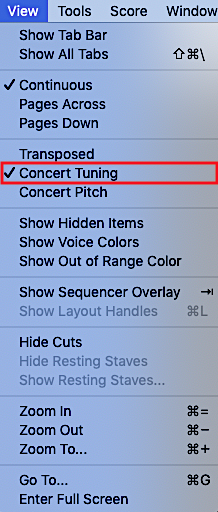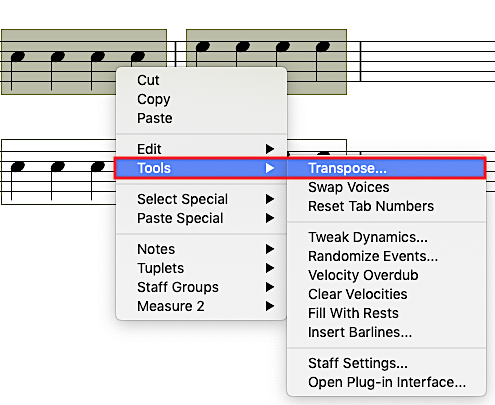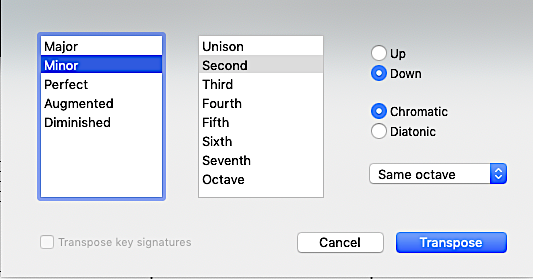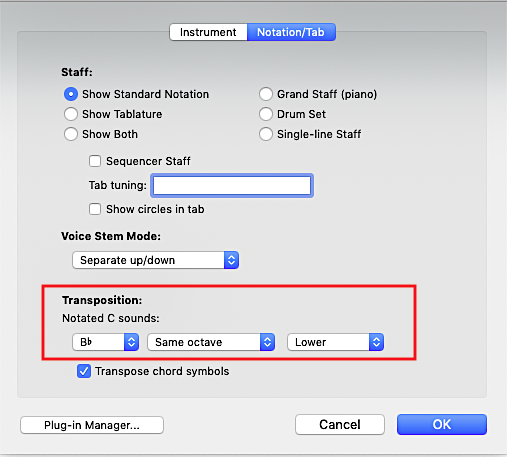Discuss Notion Music Composition Software here.
7 posts
Page 1 of 1
|
Hi,
So I've got Studio One 4 and Notion sync'd up with rewire and I'm able to input into Notion correctly and hear it in SO however it seems as though the transposition function doesn't cross over. I'm using GPO5 with the Aria player as my instrument in SO but when I change, for example, my clarinets to transpose down to Bb they are still heard as playing what's written. Any help or info would be greatly appreciated. Thanks! |
|
It does not appear to work . . .
THOUGHTS I learned how to sight-sing Classical and Baroque church music when I was in a liturgical boys choir, and since at the time I was a soprano, this is the clef I learned . . . As it evolved, soprano treble clef is the only one that makes in intuitive sense to me, which is made all the more unique by my perspective that there are 12 notes and 10 or so octaves, at least two of said octaves being solely for use either annoying or entertaining bats, birds, cats, dogs, dolphins, porpoises, sea turtles, and whales, since they are the only biologicals that can hear them . . . For electric and string bass, I set transposition in Score Setup to two octaves lower than notated, but for guitar I set it one octave lower than notated . . . I use NOTION 6 ReWire MIDI staves for everything, except Realivox Blue (RealiTone), my favorite virtual female soprano, which is the exception because keyswitches are used to control her singing and to select her phonetic scripts, all of which is easier to do when she is hosted directly in NOTION rather than in Studio One Professional 5 . . . I like horns (brass and woodwinds), and I use them in some of my songs; but as you know, the reality is that horn sections have team meetings where they devise new ways to torment electric guitar players--at least until we learn Barre chords, at which time no horn section can defeat us . . . This is the way I have tuning set if "View":  THE APPARENT PROBLEM [NOTE: I write "apparent", because so far it does not appear to be working for anything other than octaves. My recollection is that this was working sometime in the past, but it does not appear to be working in the most recent version of NOTIO 6 . . . ] I have GPO5 and its Aria Player, which I updated and reinstalled to my Mac Pro (Mid 2010) and got a new keycode, which was necessary since I recently moved from one of my Mac Pro (Early 2008) machines and am just now getting everything updated, reinstalled, and licensed for my "new" primary digital music production computer, which instead of being 13 years-ole now is just 10 years-old, but it runs macOS Mojave, hence actually is newer . . . I did a few experiments and determined that while (a) specifying transposing by one or two octaves downward works nicely with ReWire MIDI staves sending notes to Studio One Professional 5 to play VSTi virtual instruments hosted in Studio One Professional 6, it appears that (b) specifying transposition in NOTION Score Setup for different intervals from octaves is not working . . . The way I verified this was to add an Addictive Piano (XLN Audio) "Studio Grand" piano with no transposing via NOTION Score Setup, with the idea being that its "Middle C" actually would be "Middle C", hence a standard pitch to use for comparisons . . . I selected the GPO5 "Standard" n-B♭ Clarinet Solo instrument in the Aria Player . . . In the NOTION Score, I set the staff for this GPO5 clarinet to use transposition so that notated C plays B♭; but this did not work, which leads me to suggest (a) that octave transposing in NOTION Score Setup work in this scenario (ReWire MIDI to Studio One Professional 5, where the VSTi virtual instruments are hosted in Studio One Professional 5) but (b) transposing so that notated C plays as B♭ does not work . . . THE WORK-AROUND While it would be nice to have the transposing done automagically, I was not able to discover how to do it using the NOTION Score Setup "Transposition" functionality, but so what . . . There is another way to transpose; and it worked--except that it makes the music notation look a bit messy . . . Specifically, I selected the notes for the B♭ Clarinet and the right-clicked to get to the "Transpose" function on the context menu . . .   The logic is based on the idea of wanting notated C to play as B♭, which is a minor third downward in the same octave . . . Doing it this way changes all the notes by transposing them downward by a half-step . . . What was Middle C becomes the B♭ immediately below Middle C, and this is the messy part . . . All the selected notes for the staff are changed to be a half-step lower . . . I did another experiment and used E♭ for transposition in NOTION Score Setup, but it did not work . . . And I did an experiment using the native NOTION Clarinet, which also did not do transposition in NOTION Score Setup to cause notated C to play as B♭ . . . I also did the experiment using the Clarinet from Miroslav Philharmonik 2 (IK Multimedia) with the same results--not working . . . SUMMARY It doesn't work for anything but octave transposing in NOTION Score Setup . . . Starting a trouble ticket with NOTION support looks to be the best strategy at present . . . Lots of FUN!
Surf.Whammy's YouTube Channel
The Surf Whammys Sinkhorn's Dilemma: Every paradox has at least one non-trivial solution! |
|
I created a trouble ticket on this . . .
Surf.Whammy's YouTube Channel
The Surf Whammys Sinkhorn's Dilemma: Every paradox has at least one non-trivial solution! |
|
Correction: B♭ actually is a whole note below C (two half-steps not just one half-step) . . .
THOUGHTS I should have realized this sooner, but I don't use transposition this way, and it takes me a while to do the required mapping . . . Regardless, it doesn't work . . . The correct version is that A4 should be played as G4, not G#4 . . . Lots of FUN! |
|
It's important to understand that I am not focused on "transposition" as it is used in sheet music . . .
THOUGHTS There are two uses for "transposition": (1) The way notes for a transposing instrument are shown (2) The "Transposition" functionality in NOTION Score Setup NOTION has a "Transpose" tool, and it transposes selected notes, so it is a third possibility--except that it is "Transpose" rather than "Transposition" . . . EXPERIMENT I created a NOTION score and specified the native NOTION Clarinet, a native NOTION Piano, and a Basic NOTION Treble Clef, which actually is played by the native NOTION Piano. I set the Clarinet to play notated C as B♭, and this does not work. It is an error. I set the piano for the Basic Treble Staff to play its notes two octaves lower than notated, and this works correctly. The second Piano is the way it is configured by default (no changes via Transposition in NOTION Score Setup), and it works correctly. This is not in a ReWire session . . . Instead it is NOTION running standalone . . . Transposition Experiment (NOTION Score)  NOTION Score Setup ~ Custom Transposition setup for Clarinet If Transposition in NOTION Score Setup were working correctly for what I call "odd" intervals--these intervals not being octaves--then Middle C for the Clarinet should be pitched at the B♭ below Middle C (B♭3 in scientific pitch notation); but this is not what happens . . . Scientific Pitch Notation (Wikipedia) THOUGHTS ON TRANSPOSING INSTRUMENTS Like many aspects of music theory and music notation, I think the idea for transposing instruments was created centuries ago for the sole purpose of making it difficult for people to engage productively in music . . . In the early days, it also was a matter of saving paper and ink, as well as time when composing by hand, since there were no computers in those days . . . Overall, it's nonsense; and the result is a virtual festival of clefs that only a conductor and a few composers can decipher and read . . . It does not make music notation easier to read and to understand, hence my hypothesis that it was done to make it difficult for the peasants, thereby discouraging them . . . The peasants responded by creating what we now call "folk music", which generally is not notated, at all, because the peasants were unable to make sense of music notation and all its strange, bizarre, and restrictive rules . . . For me, one of the consequences of this transposing nonsense is that until a few years ago I thought the note at the 3rd fret of the low-pitch "A" string of a guitar was "Middle C" . . . What I eventually discovered is that "Middle C" on a guitar is the note at the 1st fret of the high-pitch "b" string, and "Concert A" is the note at the 5th fret of the high-pitch "e" string . . . I thought Elvis and the Beatles were sopranos; and making it even worse, I thought I was a soprano . . . Nobody told me that guitar music is notated an octave lower; and this affected the way I mapped notes to octaves, as well as the way I understood the general importance of lower pitch notes . . . It's easier to notate guitar music this way, but if you do not know that guitar is a transposed instrument, then it creates an incorrect mapping . . . It leads you to think incorrectly that "Viola C" or "Tenor Voica"--the octave above Low C--is Middle C . . . On the good side, the current version of NOTION continues to support octave Transposition in NOTION Score Setup . . . Lots of FUN! |
|
I'm not going to spend a lot of time commenting on this, but here are a few quick reactions.
A guitar is notated one octave above the notes it sounds. The definition of Middle C seems to depend on what we were taught, and the vendor who created the hardware or software. The reason for some horns to be transposing instruments? Think of different size saxophones. Should a sax player learn a different fingering for each sax? No. They know that if they finger F, it is an F on that horn, and the resulting pitch will be determined by which key the horn was built in. Otherwise, no sax player could keep the fingering straight switching between saxes of different keys. Is it possible that you have the wrong option in the View menu, where all instruments are shown in concert pitch? |
madisonfinley wroteA guitar is notated one octave above the notes it sounds. I think this is a mater of semantics and visualization. You are correct, of course . . . Middle C is portrayed as being the note at the 3rd fret of the low-pitch "A" string, but in fact is lower than actual Middle C, which is the note at the1st fret of the high-pitch "b" string . . . I think we are saying the same thing but in different ways . . . I suppose that pretending Middle C this way is the same as saying it's shown an octave higher than it actually is . . . Regardless, it confused me for decades; but after discovering Scientific Pitch Notation and a few more things, I realized that Middle C on an electric guitar is the note at the 1st fret of the high-pitch "b" string rather than the note at the 3rd string of the low-pitch "A" string . . . Even today, when I see Middle C in music notation, I visualize the 3rd fret of the low-pitch "A" string of an electric guitar, which is wrong . . . It's all the worse when I look at a bass clef staff, because to determine the correct note requires me to stop and to remember if it's two whole notes lower or higher than on a treble clef staff . . . After a few seconds, I remember that C looks like A when on a bass clef staff . . . This is the reason that for me trying to sight-read bass clef staves is simply impossible . . . My brain is hard-wired to make intuitive sense only of soprano treble clef staves . . . For reference, I use this set of names for the strings on an electric bass {E, A, D, G}; and I use them as names of the four lowest pitch strings on an electric guitar, even though they are an octave higher on electric guitar {E, A, D, G, b, e} . . . [NOTE: For me, this is intuitive since I started playing bass years before I taught myself how to play guitar . . . I do everything this way now--using soprano treble staves for nearly all instruments . . . For electric bass, I set its Transposition in NOTION Score Setup to play notated C two octaves lower, but for electric guitar I set it to play only one octave lower . . . This way, it's all soprano treble clef, which I can read on the staff; several notes below the staff; and several notes above the staff . . . For me it's easier to remember, since the notes are the same (12 notes in total) but differ by octave (10 octaves), which I suggest is mathematically elegant . . . madisonfinley wroteThe definition of Middle C seems to depend on what we were taught, and the vendor who created the hardware or software. I use a lot of IK Multimedia music software, and IK Multimedia is an Italian company . . . They consider C3 to be "Middle C", which I suppose is an European thing . . . Here in the sound isolation studio, Middle C is C4 . . . madisonfinley wroteThe reason for some horns to be transposing instruments? Think of different size saxophones. Should a sax player learn a different fingering for each sax? No. They know that if they finger F, it is an F on that horn, and the resulting pitch will be determined by which key the horn was built in. Otherwise, no sax player could keep the fingering straight switching between saxes of different keys. This is consistent with my perspective regarding 12 notes and 10 or so octaves . . . Saxophone players tend to know a lot of music theory and all that stuff, hence are what I consider to be smart folks; and at some point I think most or all of them had the epiphany that it's just a matter of octaves, which is the way I view it for everything . . . I map everything to soprano treble staves; so here in the sound isolation studio, music notation for electric bass is the same as music notation for every other instrument . . . If I want a note to be deep bass, then I play or compose it that way; and the same is true for everything else . . . The notes--and in this comparison, the finger positions--are the same; so it's only a matter of octaves . . . madisonfinley wroteIs it possible that you have the wrong option in the View menu, where all instruments are shown in concert pitch? Some of the visual representations of notes will vary depending on which of the three viewing options one prefers; but this is not the cause of the problem you have encountered . . . At first, I thought it might be just a matter of the viewing option; but after doing some experiments I determined that the problem is NOTION not doing the Transposition as specified in NOTION Score Setup . . . How you view it (Transposed, Concert Tuning, Concert Pitch) does not affect the problem . . . I consider it to be a programming error, because it does not do what it says it does . . . For example, it does not play notated C as B♭ . . . Basically, it ignores the "odd" intervals; but it correctly handles the octave intervals (one or two octaves, higher or lower) . . . NOTION 4 ~ NOTION 5 ~ NOTION 6 I clone my hard drives regularly and over time this maps to having older versions of software available . . . . In this instance, I have NOTION 4, NOTION 5, and NOTION 6; so I did some experiments, and the "odd" types of Transposition do not work in any of these version fo NOTION . . . Yet, the "octave" types of Transposition work . . . From this I suggest that the "odd" types never worked . . . For reference, this is the case with the native NOTION instruments and VSTI virtual instruments and their respective sampled-sound libraries . . . ANOTHER POSSIBILITY ~ SEND NOTES FROM NOTION TO STUDIO ONE PROFESSIONAL There is another possibility I am exploring based on a bit of advice from NOTION Technical Support, which is to send the notes from NOTION to Studio One Professional rather than to do it in a ReWire session . . . I did the experiment, and it does not key on the information specified in the Transposition section of NOTION Score Setup . . . Lots of FUN! |
7 posts
Page 1 of 1
Who is online
Users browsing this forum: No registered users and 22 guests


